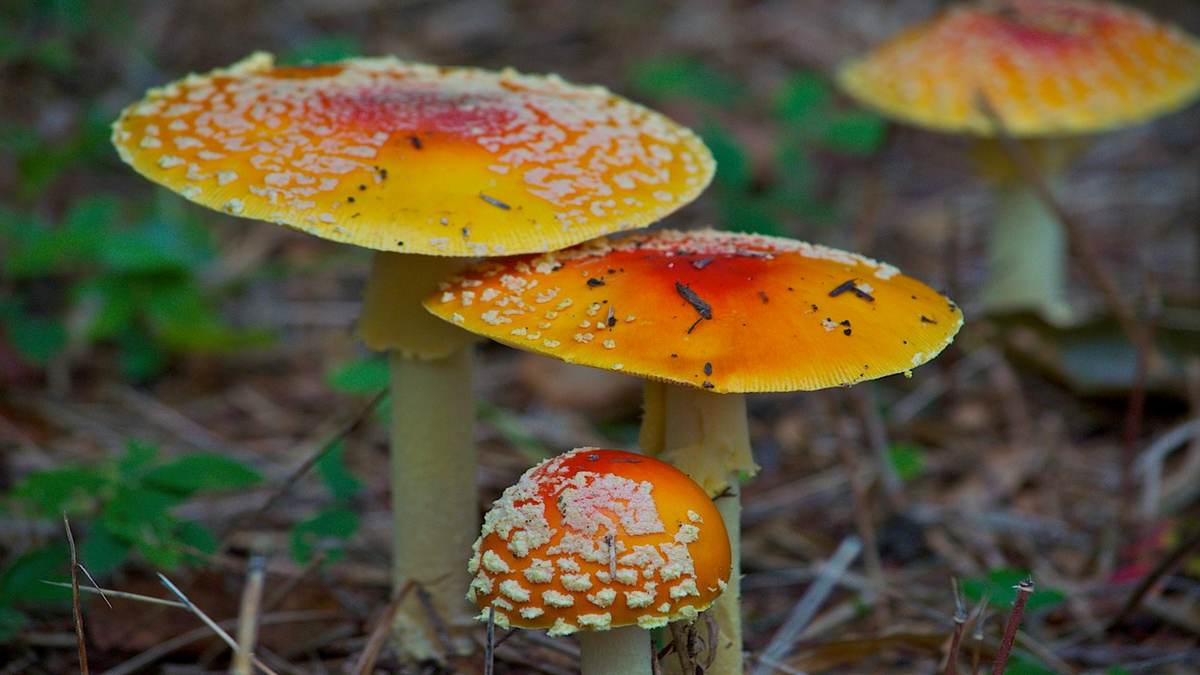
Amanita muscaria, commonly known as the fly agaric or fly amanita, stands out in the natural world with its iconic, brightly colored cap speckled with white to yellow spots. This distinctive mushroom has woven itself into the fabric of various cultural and historical narratives, sparking curiosity and caution due to its psychoactive properties and toxic constituents. This article delves into the essence of Amanita muscaria, exploring its identification, habitat, effects, and its role in folklore and modern use.
How to identify Amanita Muscaria?
Amanita muscaria is easily recognizable by its vibrant red to orange cap, adorned with white to yellow warts, which are remnants of the universal veil that covers the mushroom in its immature stage. The cap ranges from 8 to 20 cm in diameter, beneath which lie white to cream gills. The stem, or stipe, is white, 5 to 20 cm tall, and bears a ring. This mushroom’s base is bulbous, surrounded by a cup-like structure known as a volva.
Amanita’s Habitat and Distribution
Native to temperate and boreal regions of the Northern Hemisphere, Amanita muscaria has been introduced to many parts of the Southern Hemisphere, often accompanying pine and birch plantations. It forms mycorrhizal associations with trees, aiding in nutrient exchange and thriving in both coniferous and deciduous woodlands.
Amanita’s Effects and Toxicity
Amanita muscaria contains several psychoactive compounds, including muscimol and ibotenic acid, which can induce effects ranging from mild euphoria and altered perception to nausea and muscle twitching. The psychoactive properties of this mushroom have led to its use in various cultural and religious rituals. However, it is considered toxic and consumption can lead to serious health risks. Proper preparation can reduce toxicity, but the potential for harm underscores the need for caution.
Role in Culture and Folklore
The fly agaric has a rich history in folklore and has been associated with magic, witchcraft, and shamanism. It is speculated to be the “Soma” of ancient Hindu texts and has a place in Siberian shamanic traditions. In Western culture, it has been linked to the image of Santa Claus and his flying reindeer, a myth thought to originate from the shamanic practices involving the mushroom.
Amanita’s Modern Use and Legal Status
Today, Amanita muscaria is subject to legal restrictions in some countries due to its psychoactive substances. However, it continues to fascinate mycologists, nature enthusiasts, and those exploring the spiritual and psychological aspects of psychedelics. Its striking appearance also makes it a popular subject for photographers and artists.
Conclusion
Amanita muscaria embodies a blend of beauty, mystery, and potential danger. Its iconic image has permeated various cultures and sparked both awe and caution. While it continues to be a subject of scientific and cultural interest, it serves as a reminder of the complex relationships between humans and the natural world. Understanding Amanita muscaria requires respect for its potential effects and recognition of its place in the natural and cultural landscapes.
FAQ’s
What exactly is Amanita Muscaria?
Amanita Muscaria, commonly known as the fly agaric or fly amanita, is a species of mushroom found in many parts of the world. It’s easily recognizable by its bright red cap with white spots. Historically, it has been used in various cultural rituals for its psychoactive properties, but it’s important to note that it contains compounds that can be toxic if not prepared correctly. Its role in ecosystems is fascinating, forming symbiotic relationships with trees and contributing to forest health.
Are Amanita Muscaria mushrooms safe to consume?
Amanita Muscaria mushrooms contain psychoactive compounds, including ibotenic acid and muscimol, which can cause various effects on the human body. While some cultures have traditional methods of preparation that reduce toxicity and enhance desired effects, consumption without proper knowledge and preparation can be dangerous. It’s crucial to understand the potential risks and to consult with experts or credible sources before considering consumption. Safety first is a key principle when dealing with any wild mushrooms.
Where can I buy Amanita Muscaria mushrooms?
If you’re looking to explore Amanita Muscaria mushrooms, it’s essential to source them responsibly to ensure they are safe and sustainably harvested. A trusted source for these mushrooms is https://www.mycoteria.com/. They offer a variety of mushroom products, including Amanita Muscaria, with a focus on quality and safety. Whether you’re a researcher, a hobbyist, or someone curious about the cultural significance of these mushrooms, Mycoteria.com can be your go-to resource. Remember, responsible and informed consumption is crucial, so feel free to visit their website to learn more and explore their offerings.